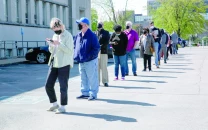Scientists may have found a way to fight blindness in young people
The trial will enroll at least 24 more patients to find success-ratio of the technique

PHOTO: REUTERS
Scientists found a technique to generate genes that can give eye sight back to people suffering from x-linked Retinitis Pigmentosa – a condition where vision weakens over time causing blindness in young people.
Scientists create first artificial mouse 'embryo' from stem cells
The surgery involves placing healthy DNA in place of the genes which maintains light sensitive cells behind the eye. Symptoms for Retinitis Pigmentosa generally show up between the age of 10 and 30. The loss of eye-sight starts from night and peripheral vision since the photo-receptors start to degenerate. The condition then affects the photo-receptors for central, detailed and colour vision – leading to complete loss of eye-sight.
Speaking about the surgery, Professor of Ophthalmology at the University of Oxford, Robert MacLaren said that the patient is “doing well and now at home, but we will have to wait a few years to know if it has stopped his retina from degenerating.”
“The effect of disease on families with Retinitis Pigmentosa is devastating and we have spent many years working out how to develop this gene therapy,” he said.
Scientists discover new organ in human body
MacLaren, who leads the trial explained that the “genetic code for all life on Earth is made up of four letters – G, T, A and C. In Retinitis Pigmentosa, however, half of the RPGR gene comprises only two letters – A and G.”
“This makes the gene very unstable and prone to mutations, making it a lead cause of blindness in patients with Retinitis Pigmentosa. RPGR is vital for the light sensitive cells at the back of the eye,” he added.
The trial will enroll at least 24 more patients to find the success-ratio of the technique.
This article originally appeared on the Telegraph.



















COMMENTS
Comments are moderated and generally will be posted if they are on-topic and not abusive.
For more information, please see our Comments FAQ